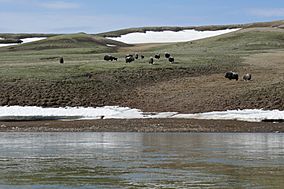Aulavik National Park facts for kids
Quick facts for kids Aulavik National Park |
|
|---|---|
|
IUCN Category II (National Park)
|
|

Herd of muskox beside the Thomsen River
|
|
| Lua error in Module:Location_map at line 420: attempt to index field 'wikibase' (a nil value). | |
| Location | Banks Island, Northwest Territories, Canada |
| Nearest city | Sachs Harbour, Yellowknife |
| Area | 12,200 km2 (4,700 sq mi) |
| Established | 1992 |
| Governing body | Parks Canada |
Aulavik National Park is a special place in Canada's Northwest Territories. Its name, "Aulavik," comes from the Inuvialuktun language, meaning "place where people travel." This huge national park is found on Banks Island, a large island in the Arctic.
The park is famous for the Thomsen River, which is one of the most northern rivers in North America that boats can travel on. Aulavik National Park is a "fly-in" park, meaning you can only get there by plane. It protects about 12,274 square kilometers (about 4,739 square miles) of Arctic Lowlands. The park is like a polar desert, which means it's very cold and dry, with strong winds. It gets only about 300 millimeters (12 inches) of rain or snow each year. Some parts of the park are high plateaus, reaching up to 450 meters (1,476 feet) above sea level.
Contents
Amazing Arctic Animals
Aulavik National Park is home to the largest number of muskoxen on Earth! Scientists believe there are between 68,000 and 80,000 muskoxen on Banks Island, and about 20% of them live in the park.
Caribou and Other Mammals
The park is also a home for the endangered Peary caribou and the more common barren-ground caribou. Other animals that live here include Arctic foxes, brown and northern collared lemmings, Arctic hares, and wolves.
Birds of Aulavik
While the park is completely treeless, it has about 150 types of flowering plants. Ptarmigan and ravens are the only birds that stay in the park all year. However, 43 different bird species visit the area during warmer seasons. Birds of prey like snowy owls, rough-legged hawks, gyrfalcons, and peregrine falcons hunt for lemmings in the park.
Marine Life
Along the northern coast of the park, you can find amazing marine mammals. These include polar bears, ringed seals, bearded seals, beluga whales, and bowhead whales.
A Look into the Past
Long ago, before the Thule culture arrived, people from the Dorset culture lived in the area that is now Aulavik National Park.
The Little Ice Age and New Arrivals
Because of a period called the Little Ice Age, Banks Island was likely empty of people for a while. Then, in the 17th century, the Inuvialuit people arrived.
Explorers and Their Discoveries
Aulavik National Park has two big bays, Castel Bay and Mercy Bay. It is located south of the McClure Strait. A famous explorer, Captain Robert McClure, spent two winters in Mercy Bay between 1850 and 1853. He was searching for John Franklin's lost expedition. McClure's team had to leave their ship, HMS Investigator, in Mercy Bay. They then walked across the sea-ice to board another ship, HMS Resolute. Nangmagvik Lake is also found within this national park.
Life in Mercy Bay
The Copper Inuit people from Victoria Island visited the Mercy Bay area. They collected materials left behind by McClure's team. They also hunted caribou and muskoxen, and you can still see many old food storage sites they used.
In the 20th century, the area became popular with the Inuvialuit because there were many foxes. People from places like the Mackenzie Delta and Alaska came here to trap foxes for their fur. This fox trapping helped people earn money. As more people came, the community of Sachs Harbour was created. It is the only town on Banks Island.
See also
 In Spanish: Parque nacional Aulavik para niños
In Spanish: Parque nacional Aulavik para niños
- List of National Parks of Canada
- List of protected areas of the Northwest Territories

